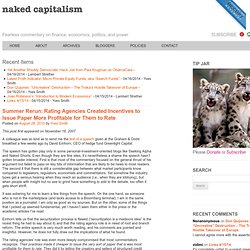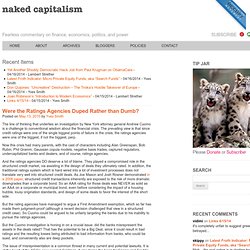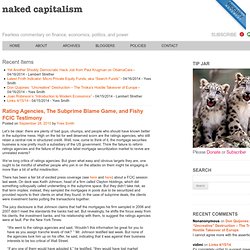

Summer Rerun: Rating Agencies Created Incentives to Issue Paper More Profitable for Them to Rate. This post first appeared on November 16, 2007 A colleague was so kind as to send me the text of a speech given at the Graham & Dodd breakfast a few weeks ago by David Einhorn, CEO of hedge fund Greenlight Capital.

The speech has gotten play only in some personal-investment-oriented blogs like Seeking Alpha and Naked Shorts. Even though they are fine sites, it’s nevertheless a shame the speech hasn’t gotten broader interest. First is that most of the commentary focused on the general thrust of his argument but failed to pass on key bits of information that are likely to be news to most readers. The second it that there is still a considerable gap between what market participants know compared to legislators, regulators, economists and commentators. It was sobering for me to learn a few things from the speech. Morgan Stanley, Moody's, S&P must defend fraud claims. Unsealed Documents Expose Morgan Stanley Forcing Rating Agencies To Inflate Ratings.
With Europe, the BBA, and virtually everyone shocked, shocked, that the global bank cabal schemed and colluded for years to manipulate interest rates, so far only America appears relatively blase, and totally ignorant, about the issue.

Perhaps it is because the first bank exposed in the manipulation scheme so far is European, perhaps because it is just tired of all the endless crime coming out of the criminal complex known as Wall Street. It is unclear. From Bloomberg: Morgan Stanley successfully pressured Standard & Poor’s and Moody’s Investors Service Inc. to give erroneous investment-grade ratings in 2006 to $23 billion worth of notes backed by subprime mortgages, investors claimed in a lawsuit, citing documents unsealed in federal court....The unsealing of the internal documents from Moody’s and Standard & Poor’s came in one of the largest ratings lawsuits to emerge from the 2008 financial crisis.
This is where it gets good: And the punchline: Turns out someone noticed. Hot new filing claims internal docs show rating agencies lied on MBS.
A Formula for Gaming the Ratings Agencies. The 2007/8 financial crisis. Were the Ratings Agencies Duped Rather than Dumb? The line of thinking that underlies an investigation by New York attorney general Andrew Cuomo is a challenge to conventional wisdom about the financial crisis.

The prevailing view is that since credit ratings were one of the single biggest points of failure in the crisis, the ratings agencies were one of the biggest, if not the biggest, perp. Now this crisis had many parents, with the cast of characters including Alan Greenspan, Bob Rubin, Phil Gramm, Gaussian copula models, negative basis trades, captured regulators, undercapitalized banks and dealers, and of course, ratings agencies. And the ratings agencies DO deserve a lot of blame. They played a compromised role in the structured credit market, via assisting in the design of deals they ultimately rated. In addition, the traditional ratings system which is hard wired into a lot of investment processes does not translate very well into structured credit deals.
Yves here. Rating Agencies, The Subprime Blame Game, and Fishy FCIC Testimony. Let’s be clear: there are plenty of bad guys, chumps, and people who should have known better in the subprime mess.

High on the list for well deserved scorn are the ratings agencies, who still retain a central role in structured credit. Well, now, come to think of it, the mortgage securities business is now pretty much a subsidiary of the US government. Think the failure to reform ratings agencies and the failure of the private label mortgage securitization market to revive are unrelated events? We’ve long critics of ratings agencies. But given what easy and obvious targets they are, one ought to be mindful of whether people who join in on the attacks on them might be engaging in more than a bit of artful misdirection. There has been a fair bit of excited press coverage (see here and here) about a FCIC session last week. The juicy disclosure is that Johnson claims that half the mortgages his firm sampled in 2006 and 2007 didn’t meet the standards the banks had set. Earth to base. Where Did the Risk Go? How Misapplied Bond Ratings Cause Mortgage Backed Securities and Collateralized Debt Obligation Market Disruptions by Joseph Mason, Josh Rosner.
Joseph R.

Mason Louisiana State University - Ourso School of Business; University of Pennsylvania - Wharton Financial Institutions Center Josh Rosner Graham Fisher & Co.May 3, 2007 Abstract: Many of the current difficulties in residential mortgage-backed securities (RMBS) and collateralized debt obligations (CDOs) can be attributed to a misapplication of agency ratings.